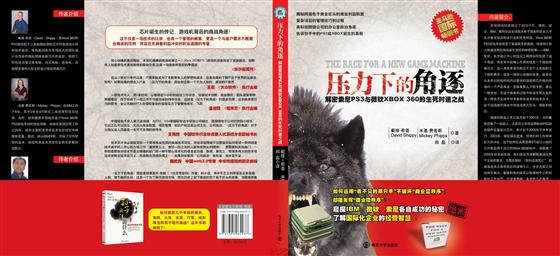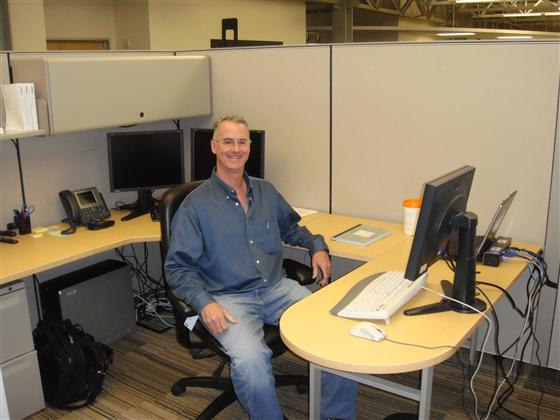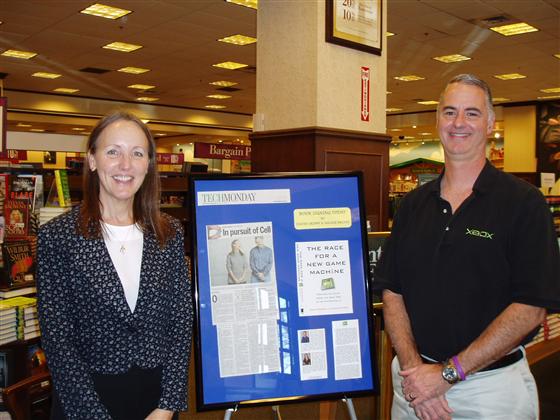《压力下的角逐:解密索尼PS3与微软XBOX360的生死时速之战》
英文书名:The Race For A New Game Machine
出版社:南京大学出版社
作 者:戴维‧希普
米基‧费普斯
译 者:郑磊

这是我第一次出版翻译作品。
一、作者介绍:
戴维‧希普David Shippy
微软Xbox360和索尼PS3游戏机个人电脑徼处理机芯片的首席设计师和技术指导。20多年带领庞大的团队设计高性能的微处理器电脑芯片的经验。包括为笔记本电脑,台式电脑,游戏机,高端服务器和大型主机设计微处理器芯片。现为一个开发微处理器的公司的副总裁。

米基‧费普斯 Mickie Phipps
曾就职于美国空军20年,主要职责是研究开发对空导弹搜索装置。后就职于IBM,在STI担任二线经理和项目经理时,与戴维率领团队设计Xbox360和PS3游戏系统的微处理器。最近,她从IBM辞职。开始了写作梦想的追求。她现和她的丈夫杰里住在得克萨斯的佥斯兰。

二、内容介绍:
全球游戏玩家超过了3亿五千万,微软、索尼、IBM、英特尔这全球四大电子商务的巨头几乎瓜分着全球高科技行业的所有利益。Xbox360和PS3游戏系统改变了家庭娱乐的面貌。但是很少有人知道这两款游戏诞生背后的神奇故事——IBM/索尼/东芝设计中心的顶尖工程师如何创造了这个奇迹。而在其中起核心作用的仅是一个微处理器芯片,这一具有革命性的芯片为个人电脑树立了新的典范。这是一场惊心动魄的竞赛,能否在从未有过的短时间内以最快的速度将芯片推向市场对一个产业来说,意味着要么大获全胜,要么一败涂地。在这个艰难的过程中执掌生死大权的是一群名不见经传却有着孜孜追求的技术天才。在这场激烈的商战中的是两大巨头:微软和索尼。
艰难的新品上市之旅开始于2001年,当时戴维召集了一批能人。为索尼公司热切期盼的PS3游戏操作装置设计芯片,并计划于2005下半年发行。2003年,微软插足进来,给他们的工作带来巨大的冲击.这个软件巨头希望将STI设计小组的芯片新品用于自己的Xbox360游戏中,也瞄准了2005年的圣诞市场。他们使出浑身解数来满足两个主顾的要求,力图在微软的“胜利或是死亡”破釜成舟之势和索尼的谨慎小心,步步为营之间找到平衡点。戴维和他的组员以每周80个小时的疯狂工作状态,忍受着焦躁,友谊的几近崩溃,绝望,最终取得了胜利。
这本书的灵魂是对高新技术世界里技术人员色彩纷呈的幕后生活的描述,全面深入细致地展示了发生在世界两大知名电脑游戏机背后的技术秘密和诞生的过程,其最大的特色是一系列让人难忘的角色,高水平的合作方式,令人扼喉的商业交易,推动技术进步的的宏大远见激励STI的设计师们毅然投身于芯片的设计中。整本书中,作者总结了自身经验,揭示了领导力的诀窍,包括团队动机的激发,创新精神的培养,勤奋的工作和寓乐于工作之中。
三、主要看点
这不仅是一场技术的比拼,也是一个管理的教案,更是一个与客户需求不断磨合推进的范例,而且还充满着利益冲突的职业道德的考量。
1.揭秘跨国电子商业巨头的商业利益联盟
IBM,INTEL,MICROSOFT,SONY这四家电子商业巨头高水平的合作方式,无人知晓的令人扼喉的商业交易,他们中间的商业利益联盟与欺骗、欺诈。微软如何介入游戏机领域,IBM如何处理好同索尼、东芝的联盟,又同时拉住微软,充满了风险……揭示了游戏机核心设计的秘密,索尼PS3和微软XBOX核心技术和成功的秘密。
2.IT 精英浮世绘 复杂项目的管理技巧和过程
高压下、面对“高效率”团队的管理:面对一群最有个性的IBM,INTEL,MICROSOFT,SONY的各方天才们,欺骗手段、耍滑技巧无比高明,稍有不慎,将前功尽弃,全军覆没。如何将合适的技能与个性组合,最小化混乱、最大化成功;
3. 高科技跨国司的办公室政治角逐:
只要有人的地方就会有政治,IBM的办公室政治该怎么玩?这些技术精英,同时也是政治高手,在高科技企业里,该如何抢夺项目资金,如何招聘技术高手,如何应对多文化冲突,如何远程管理项目团队,如何使用好女性员工……跨国企业文化冲突与管理,对中国企业国际化经营的启迪
4.IT资深人士的人生体验和经验分享、偏执狂和自恋狂的小世界
在高科技行业面对对高压的工作,复杂的人际办公政治斗争。紧张的研发日程带来的压力如何化解,并非一句“能干会玩”那般简单,碰到难以逾越的问题时,如何寻找解决方案,在茫无头绪和太多选择间徘徊,是设计师的生活常态,本书同时也给出了很多缓解与解除压力的方法。
四、读者范围
1、跨国IT企业中高层的项目管理人员、其他企业的项目负责人;
2、国内其他企业需要学习如何处理复杂,需要多方合作项目负责人,以及项目管理者;
3、想了解跨国高科技企业的内部运作、想从事相关职业的学生以其他人员。
4、其他对IBM,INTEL,MICROSOFT,SONY的产品设计感兴趣的读者;
目 录
引子: 进退维谷的选择
正在冲刺索尼PS3微处理器芯片的团队忽然接到了客户索尼的竞争对手微软的巨额订单,如何在一个市场季节,同时为两家利益冲突的客户推出同样高水准的产品,如何用技术手段化解道德冲突,实现IBM、索尼、微软三方共赢的局面,一场角逐大幕徐徐拉开……
第一章 圣杯之梦
离开IBM投身互联网淘金的技术大腕重新被收编,等待他的是重头再来,从一张白纸开始,设计出世界上频率最高、性能最佳的索尼PS3游戏机处理器芯片,这就像是夺取圣杯的梦想,崇高而艰巨。
第二章 打造梦幻团队
只要有人的地方就会有政治,IBM的办公室政治该怎么玩?这些技术精英,同时也是政治高手,本章告诉读者,在高科技企业里,该如何抢夺项目资金,如何招聘技术高手,如何应对多文化冲突,如何远程管理项目团队,如何使用好女性员工……
第三章 核心竞争力在哪里
CISC和RISC哪个更优秀?IBM是如何与INTEL竞争的?作者从技术角度解密了这段历史悬案。IBM/索尼/东芝联合开发团队该为新一代革命性的芯片确定什么样的标准呢?四倍于现有芯片时钟频率、耗电不到75瓦,无论你认为是激进还是疯狂,这就是竞赛的标杆……
第四章 冲锋前的准备
作为新一代游戏机的首席架构师和技术指导,生于70年代的我,过去很少接触视频游戏,必须恶补这块知识。作者讲述了游戏机的发展史,以及关于图形界面、软硬件、游戏机的操作系统等概念。
第五章 创新“魔法弹”
创新是艰难的。电路设计、总线结构、存储系统、输入输出,所有设计都要在方寸大的硅芯片上实现,而且相互匹配达到最优效果。本章揭秘PS3游戏机核心部分是如何设计,IBM工程师如何克服文化和语言障碍与日本工程师协同工作……
第六章 会玩能干
紧张的研发日程带来的压力如何化解,并非一句“能干会玩”那般简单,碰到难以逾越的问题时,如何寻找解决方案,在茫无头绪和太多选择间徘徊,是设计师的生活常态。
第七章 突如其来的工程变更
在设计图纸已大部分完成,按计划制作测试原型时,索尼的久多良木健忽然提出要将原先设计的六个同步核增加到八个。这会导致重新做电路排版,芯片体积和耗电增加,还可能影响到测试原型的按时推出。团队只有承担风险,全力以赴闯关……
第八章 何事无风险
正当索尼PS3游戏机芯片开发进入佳境,不速之客微软敲门而入,比尔·盖茨想借助IBM之力,在2005年圣诞节期间推出其游戏机拳头产品XBOX360,不仅和索尼项目时间巧合,而且微软看上的竟然也是同样的威力电脑芯片设计。本章讲述了微软如何介入游戏机领域,IBM如何处理好同索尼、冬芝的联盟,又同时拉住微软,充满了风险……
第九章 积极面对争议问题
为了赶上进度,必须尽快解决人手问题,阿科洛特不得不面对充满怨言和愤怒的赖利团队,同时,由于微软的加入,芯片设计思路必须调整,采用共同的核设计,才有可能同时满足客户的要求,如何平衡两个竞争对手,如何面对伦理冲突、技术冲突、文化冲突,如何在两个竞争项目之间建立有效的防火墙……
第十章 步步为营
共同核设计完成之后,IBM必须抓紧微软项目的芯片外围设计,这个过程仍然充满了分歧和挑战,同时接受内部其他部门的挑剔的项目阶段评审。评审结果预示,微软项目如果按照常规流程进行,将比原计划脱期四个月,疲惫不堪的团队不得不作出“要么成功,要么死亡”的艰难抉择……
第十一章 先见之明的艺术
时间来到2004年,只有一年的时间完成微软芯片设计,和索尼芯片同时推出。我们决定冒险跳过验证流程,直接进入后续设计流程,任何错误都将使计划泡汤,我们必须能够提前预测到可能出现的问题,这不仅需要复杂的工程技术手段,而且更需要创造力……
第十二章 星星之火
第一款试验芯片终于成功下线!尽管还有不少缺陷要排除,毕竟是一个阶段性的成功。哪怕成功只是偶然,尽管团队已经筋疲力尽,在最后冲刺阶段,再微小的成功都应该真诚庆贺,我们在积攒全部力量冲向终点。
第十三章 高科技世界的3P
规划、执着、耐心是在高科技行业生存的基础。每当我们找到并消灭试验芯片中的一个“虫子”,总会发现新的问题,为赶时间,微软决定跳过硬件小批量试验,直接将设计的产品原型付诸量产,结果微软按时推出了产品,获得了巨大成功,索尼则因为图形芯片的延误推迟到2006年春天推出。意外的是,厌倦了公司政治争斗的阿科洛特,四月份离开了IBM……
尾声-成功后的人生感悟
索尼和微软终于按期推出了各自的秘密武器,并取得巨大成功。IBM也将继续尝试为这款威力强大的芯片设计更多的产品。久多良木健虽继任索尼CEO的呼声最高,但终因公司政治原因黯然退休;作者重新回到了创业小公司。经过这样一个复杂微妙和兴奋刺激的大项目的洗礼,作者感悟到了几条人生金言,与大家分享。
作者DAVID还专门为中文版撰写了前言:
成功领导力
《压力下的角逐》这本书的作者是戴维·希普和米基·菲普斯,他们讲述了给予Xbox360和PS3这两款游戏机生命的芯片诞生的真实故事,一个令人惊讶的高科技世界背后的传奇!
当我们坐下来写这本书的时候,我们就知道我们将告诉广大的读者一个独一无二的精彩故事。异常紧迫的时间表、顶级秘密任务分工、激情洋溢的员工们、刚愎自用的领导和有竞争关系的两大客户,这些因素加在一起构成了一个在美国任何一家企业都会有的高压工作环境。任何一个员工都与书中的这个故事有牵连。这是关于人和团队的故事,是他们创造了第一无二的高利润产品——Xbox 360和PS 3游戏机芯片。这不是对高科技的无稽之谈,而是一个关于一群碰巧制造这些微芯片的人的真实故事。
索尼、东芝、IBM(STI)联盟的倡导者们将行业中的芯片制造佼佼者们融到了一起,开创了家庭娱乐行业的新纪元。他们从德克萨斯州、德国、纽约、北加利福尼亚和明尼苏达州调集了IBM的芯片设计精英,并吸纳来自顶尖大学,如普渡大学等的一些刚毕业的大学生以必要的补充力量,此外还有来自索尼和东芝的曾参与设计PS2的顶尖工程师。他们推动了技术前沿,远超人们所能想象到的程度。他们成功地设计出了世界上运行速度最快的微处理器——微软的Xbox 360 和索尼的PS 3游戏机的大脑。
领导原则
为Xbox 360和PS3设计芯片是一次惊心动魄的历险,经历中不乏易怒的行政高管、精神高度紧张的工程师们和不可能完成的最后期限。但这也是一次值得的经历,能成为这个团队的一员,我们很幸运。当我们超越了目标,或者某位工程师超水平完成了我们所指派的任务,或者当上司对我们的工作给予褒奖时,我们倍受鼓舞。当我们的团队在指定期限内制造出世界上最快的芯片时,我们最终觉得所经受的一切的苦难都是值得的!
完成了这个项目后,我们从自己的成功经验中获得很多东西,但是,有时候,更多重要的经验教训来自我们所犯下的错误。在历经了血、泪和汗的洗礼后,成功是如此地甜蜜。我们学到了并且应用了一些重要的原则,这些原则曾帮助我们的团队获得成功,至今我们都一直从中获益。我们相信,我们的团队能够按照时间表完成项目目标,尽管几经挫折,我们仍深信不疑。我们也证实了,“我能”的态度是有感染力的!
在我们的书中,我们重点列举了一些重要的领导策略,那些是我们在成功完成项目后的感悟。以下是这些经验教训的核心摘要。
1. 鼓励大胆的设想
在每一个成功的技术成果的中心,都存在着一个大胆的构想,它鼓舞着团队。将深厚、持久的激情和非凡的专业知识结合起来,你就拥有了大胆构想的资本。很幸运,我们的团队中不止一位成员拥有这些非凡的品质,正是他们勇于挑战的伟大梦想使我们的团队更加努力地工作。我们被充满无限可能的未来鼓舞着。
先知们激励着我们表现良好的团队去创造、去冒险,专注于我们的目标。当我们的构想正确就会得到奖励,而我们的失策也会带来不幸。制定一个有可能完成的里程碑和明确的界限就可以预测到未来。就是这么神奇,这就是路线图。在沿着这张地图行走的途中,如果你必须要这么做的话,可以修改地图,但是你要知道,这张地图在创造工作,也在提供混乱的机会。最好在起点处就做出正确的决定,只要计划被一再斟酌、磨练过,哪怕开始的时间有些延误也没关系——尽量减少变化带来的影响。
2. 建立一个成功的团队
建立成功团队的第一步就是要招聘高级人才和拥有真正领导能力的人作为种子选手。接下来就是要组织各种学科能人和领导者,以最大化成功几率。STI团队就是高度多样化,且拥有一批将他们大部分的时间用来创造Xbox 360和PS3游戏机芯片的能人工程师。但是,将这个团队的人聚集到一起并不是一个偶然或者是巧合。这是经理和技术领导人共同努力的成果,他们知道组建团队只是一个开始。我们曾不断重视技能和个性的结合,调整分配结构,提高熟练程度,并使人不断提高自己的能力、表现。这需要绝对地专注和坚持。
团队动力学机制复杂而难以捉摸,且充满了欺骗。有很多谚语——“一粒老鼠屎坏了一锅粥”;“油水不相容”,又亦或是“链子的强度取决于最薄弱的那段”都是如此地真实!将一帮天才们集中到一个项目中并不能保证成功,除非他们之间能认同彼此。通过正确权衡好团队中成员的技能和个性来最小化冲突、最大化追求卓越的欲望。人们通常在自己喜欢的或是尊敬的人身边工作时工作状态最佳,而且一般来说,重新创建一个完美的团队要比协调一个已经存在的团队容易得多。你对个人的技能方面花了多少心思,对团队力你也至少得花同样的心思。
3. 了解你的竞争力,做一些功课
激励我们更优秀,从而拥有更多机会的就是竞争力。对竞争能力的准确评估有助于我们为宏伟大计制定目标范围。我们得确保自己已跳得足够地高。
在这个故事中的每一个角色——索尼、东芝、IBM和微软都得参加不同的比赛,去打败不同的对手。他们不一样的竞争力度和所要达到的成果有助于我们制定项目目标。
对付那些想要分享你的市场份额的竞争对手,必须得对你的竞争对手知根知底,它的作用是无可替代的。要细致地评估对手,得花时间、运用知识和工作能力,但最终你会有回报的:在市场中可以更快地应对市场的变化。你的产品将会具备消费者想要的产品特征,你也一定会得到超预期的结果。应对新一代产品挑战的唯一方法就是做功课——研究过去,分析市场,进行整体调研并且从前人所犯的错误中吸取教训。倾听团队的声音,运用他们从工作中得来的知识。
4. 激励创新
要不是依靠创新的翅膀,我们是不可能达到如此高的芯片设计目标的。没有人做过我们计划要去做的事。与一般人的想法不同,创新的思流不会像打开龙头就会自动流出来那么简单。激励来自于解决问题的挑战。你得循循善诱地引导出新奇的想法,然后仔细解剖、分析它们。这项工作需要拥有熟练技巧和专业知识的教练和不怕挫折的发明者。
我们过去所做过的事情中没有一样能满足完成我们伟大构想所需要的条件。创新是,而且一直都是确保成功的神奇种子。
5. 能玩会干
芯片设计是一项让人精疲力竭、高度紧张且异常复杂的工作,如果我们没有一种不断提振士气的方法,我们将不可能坚持到最后。我们的消遣时间强化了成员间的关系,那些无价的无形资产促使我们每天都想去上班。我们的庆祝会让我们的成果显示在聚光灯下,让我们意识到我们自己的进步。我们觉得自己就是个获胜者。
努力工作已取得最后的胜利,尽情地娱乐以放松心情保持清醒的头脑。没人能比同事们更了解日复一日地坚持需要多么艰辛地努力。
6. 敢冒险
来自成功的满足感,确信我们正在沿着正确的路线前进,以及从工程师和领导层那里得到的力量和支持,有了这些,我们相信我们是不可战胜的。我们会带着一个新奇的想法行动起来,挑战过时的技术,或者承诺一个几乎不可能完成的时间表。我们肩并肩地站着,信念坚定地向前迈步,因为我们的肩负领导层的信任,这种信任就像是给我们安装上了翅膀一样。
承担风险迫使我们专注未来,跨出下一个大步。我们大跨步地开始了创新历程。因为万事都是相对的,所以请记住,每件事都是有风险的,然而,每个风险都是一个机会。
7. 要乐观,即使处于争论的漩涡中
当然,“所向无敌”的轮子在往前开进的过程中不可避免地需要经受现实的检验。我们的工作量相当庞大,但给我们的时间却很有限,很多双眼睛都在注视着我们。保持乐观的心态能让我们始终专注于我们所期望的结果,即便是在我们被那些说三道四的人引诱想要投降的时候,也不会轻易放弃。
不满可以像疾病一样传播开并摧毁团队坚持不懈的意志。在创新进程中错误产生了,分歧也就跟着来了。领导者的工作就是从争议中找出闪光点,并将它们重新组合成一个有现实积极意义的成果。
8. 保持速度
当时间成为关键因素的时候,快速决断才能成功。相信你的直觉,减少在决定上的争议。一个充分的讨论需要较长时间才能达成共识,改进计划。但是当让团队继续推进项目的进程更加重要的时候,领导者得认识到每个项目的那些关键时刻,得加以控制。
9. 要具有前瞻性,要能预见问题,让人人都有责任心
在设计工程过程中,有两种问题:一种是复杂的谜团,需要激发工程师的创新方法解决;另一种是会淹没工程师的创新精神的错误。谜团问题就是我们为什么喜欢工程设计的原因——我们喜欢将自己沉浸在追求答案中。但是其他的问题,那些潜在的本可以避免的问题出现在我们面前,非常令人恼火。作为一个领导者,提前预料出那些恼人的问题是一种艺术形式。这得需要经验、预见性和对团队的深入了解,他们的技术以及你得去满足的他们的要求是什么。惊喜对项目有利,所以要有前瞻性,在问题变得失控之前就预料到这个棘手的问题。
10. 庆祝成功
抓住每一个机会庆祝成功,即使你并不喜欢这样,即使你很累,已经精疲力竭了,即使这个成果更多的是因为运气好而不是因为技术过硬的关系。在庆祝会上投入些,精力充沛些,还要富有创造力,让你的团队看到你真心地赞赏,让你发言激发团队新一轮的活力和激情。
创造一个好的庆祝环境,你的团队会对此叫好的。每一个成功都得庆祝,不管这个成功是多么小的一个。尽管最后你得为你们所吃的食物付钱,但是鼓励不会花太多的钱,但它的作用却会很持久。你的预算应该得包括创造出现实利益的表现好的员工们。
11. 预先计划,坚持不懈,要有耐心
计划、坚持和耐心——这三个P打头的词是在高科技世界里生存的法则。预先考虑好,倾听来自你团队的声音,做好你该做的功课并且运用好信息来开展最好的计划。告诉你的团队,你乐意在最初时花时间和精力确定好正确的方向,他们也会为之而尊敬你,会追随你的步伐。当遇到困境时,不要放弃。每一项工作都具有挑战,每一个挑战都会提供一个让你跨越的机会。深吸一口气,然后继续前行。
最后的话
具有如此重大意义的芯片设计项目是一次足以改变生活的经历。那段时期都是美好的日子,充满了回忆,那时我们感觉自己就像是站在费城艺术博物馆最高台阶上的洛奇·巴博一样。我们是胜利者!然而,这辆“过山车”很快就陷入了欺骗的“谷底”中了,我们面临着灾难。这是一项测试你勇气和斗志的工作。
我们写这本书,部分是因为我们想吸引那些敢在这样一个时间表上进行创新的聪明与勇气兼具的科技男女们的注意力。如果我们能激发一些坚韧的青年学生来挑战这项工程事业,并最终可以在自己设计的破纪录的芯片上用手指灵活地操作,那么我们才可以说,我们成功了。也许我们还能够拿着手电筒给一些其他的领导者照着他们的科技项目指路,希望他们能在这条路上避开一些障碍物。然而,即便我们所做的只是用这个有趣的故事给读者们带来欢乐,我们也就知足了。
LEADERSHIP FOR SUCCESS
By David Shippy & Mickie Phipps
David Shippy and Mickie Phipps are the authors of The Race for a New Game Machine, the exciting true story behind the creation of the chips that give life to the Xbox360 and the PlayStation 3. It is a dazzling, behind-the-scenes account of life in the tech world.
When we sat down to write our book, The Race for a New Game Machine, we knew we had a unique story to tell that would appeal to a broad range of readers. The combination of a brutal schedule, top-secret assignments, passionate workers, domineering leaders, and competing clients made for a pressure-cooker work environment that could have been created in any industry in the United States. Everyone in the workforce can relate to the story in this book. It’s about the people, the team behind the unique, high-profile products we developed – the chips for the Xbox 360 and the PlayStation 3. It’s not a bunch of high-tech mumbo-jumbo, but is instead a story about the people who happen to make microchips.
The founders of the Sony/Toshiba/IBM (STI) Design Center took a melting pot of the best chip-making talent in the business and revolutionized the home entertainment industry. They enlisted the smartest IBM chip veterans from Texas, Germany, New York, North Carolina, and Minnesota, beefed up that team with young hotshot grads from top universities like Duke and Purdue, and then added the best PlayStation 2 engineers from Sony and Toshiba. They were hot, and they pushed the leading edge of technology farther than anybody dared to hope. They successfully designed the fastest microprocessors in the world, the brains of both the Microsoft Xbox 360 and the Sony PlayStation 3.
Leadership Principles
Designing the chips for the Xbox 360 and the PlayStation 3 was a harrowing experience, filled with hot tempered executives, stressed-out engineers, and impossible deadlines. But it was also extremely rewarding, and we were fortunate to be a part of it. When our team exceeded the goals, or when an engineer grew into the stretch role we’d assigned to him or her, or when our bosses – and they were legions – gave praise for the job we’d done, we were encouraged. And when our team delivered the fastest chips in the world on schedule, we finally felt it had been worth all the pain.
Throughout this project, we got lots of things right, but sometimes the most significant lessons came from our mistakes. Success is so much sweeter when achieved through a little blood, lots of sweat and even a few tears. We learned and applied important life principles that helped us succeed as a team and that help us still today. We believed our team could meet the project goals and schedule, and in spite of many setbacks, we never stopped believing in them. And they proved us right. A can-do attitude is contagious.
In our book, we highlighted the most important leadership strategies that, partly only in hind-sight, we know made our project successful. The excerpts and paraphrasing below capture the essence of those lessons.
1. Inspire a bold vision
At the heart of every successful technical accomplishment, there first existed a bold vision that inspired the team. Combine a deep and abiding passion with a vivid imagination and extraordinary expertise, and you have the makings of a visionary. We were fortunate to have more than one of those rare individuals on the Xbox 360 & PlayStation 3 project, and it was their grand dreams of challenge and glory that enticed our teams to work harder than ever. We were energized by a future lined with possibilities we had never before imagined.
These prophets inspired our high-performance team to create, to take risks, and to stay focused on the goal. The rewards that fell into our laps when we got that vision thing right, and the misfortune that befell us when we got it wrong, taught us how crucial that first step really is. Building the right plan with achievable milestones and realistic boundaries is kind of like divining the future. It’s that powerful. It’s the map.
Revise the map as you go along if you must, but realize that it creates work and the opportunity for confusion. Better to start right – even delay the start until the plan is honed – to minimize the effects of change.
2. Build a team for success
The first step to building a highly successful team is to recruit top talent and seed the team with true leaders. The next step is to organize the various disciplines and leaders to maximize success. The STI team was highly diverse and full of talented engineers who devoted a big chunk of their lives to creating the chips for the Xbox 360 and PlayStation 3 game consoles. But it was not chance or coincidence that brought this phenomenal group together. It took a concerted effort of managers and technical leaders who understood that assembling the team was only the beginning. We gave constant attention to the mix of skills and personalities, tweaking assignments, building proficiency, and shuffling people to optimize performance. It took absolute focus and die-hard persistence.
Team dynamics are tricky, slippery, and full of treachery. All the old adages -- one bad apple can spoil the whole basket, oil and water don’t mix, or the chain is only as strong as its weakest link -- are so true! Putting a bunch of geniuses together to work on the same project will not guarantee success unless some level of agreeableness and acceptance exists between them. Minimize turmoil and maximize the desire to excel by carefully juxtaposing the right skills and personalities on your team. People work best around people they like and respect, and it’s often easier to create that perfect mix from scratch than to correct an imbalance in an existing team. Pay at least as much attention to the team dynamics as you do to the individual skills. Work very hard to make the right choices up front.
3. Know your competition and do your homework
It is competition that drives us to higher levels of excellence and, therefore, to more opportunity. An accurate assessment of our competition’s capabilities is what enables us to refine the boundaries of our bold vision. We must make sure we shoot high enough.
Each player in this saga – Sony, Toshiba, IBM, and Microsoft – had a different race to run, a different set of rivals to beat. The strengths and accomplishments of the competition, as varied as it was, helped shape our project goals.
There’s no substitute for an accurate understanding of the rivals who seek to sweep your market share into their own bucket. It takes time, knowledge and work to create a thorough assessment, but in the end, you’ll respond faster to changes in the market. Your product will have those winning characteristics that your customers want, and you’ll be more likely to overachieve than to miss the mark. The only way to be prepared for the unique challenges of the next generation product is to do the homework--study the past, analyze the market, research the entire scope of the problem, and learn from the mistakes of your predecessors. Listen to your team and utilize the knowledge they’ve gained throughout their own careers.
4. Inspire innovation
We couldn’t have reached those lofty chip-design goals without flying there on the wings of invention. No one had ever done the things we set out to do, and contrary to popular belief, creative juices don’t just flow from a spigot with an on/off knob. Inspiration comes from the challenge of solving problems. You have to coax novel ideas into the light, then carefully dissect and analyze them. It takes a coach with finesse and expertise, and an inventor with thick skin.
Nothing we have done in the past is sufficient for what we need now to fulfill the grand vision. Innovation is and always will be the magic bullet that insures our success.
5. Work hard, play hard
Chip design is exhausting, intense, complicated work, and we couldn’t survive it without a way to re-energize. Our playtime reinforced interpersonal relationships, those priceless intangibles that made us want to come to work every day. Our celebrations put a spotlight on our accomplishments and helped us recognize real progress. It made us feel like winners.
Work hard enough to win, play hard enough to stay sane. No one understands better than co-workers the extraordinary effort it takes to persevere day after day. Who better to share in the release after having been in the trenches together?
6. Enable risk taking
The satisfaction that came from winning, the certainty we were on the right path, and the strength and support we gained from our fellow engineers and leaders – with these things, we believed we were invincible. We could step out on a limb with a new idea, challenge an outdated technological truism, or commit to a near impossible schedule. We stood side-by-side and stepped out in faith, emboldened by the trust of our leaders draped across our shoulders like wings.
Risk-taking forces us to focus on the future, to take that next big step. It jump-starts the creative process. And while it’s all relative, remember that everything’s a risk. And every risk is an opportunity.
7. Stay positive, even in the swirl of controversy
Of course, on the heels of invincibility comes the inevitable reality check. We had a huge plate load of work, very little time to do it, and many eyes watching us. Staying positive kept our focus on the desired results, even when it was so tempting to surrender to the nay-sayers.
Discontent can spread like a disease and destroy a team’s will to persevere. Mistakes occur in the natural course of the creative process, and disagreements arise. The leader’s job is to take the nuggets revealed through that controversy and piece them together into a realistic positive outcome.
8. Keep Up The Pace
When time is of the essence, success demands fast decisions. Move on to the next problem. Trust your instincts. Limit debate on the decision. There’s a time and place for extended discussion, efforts to reach consensus, and refinement of the plan, but a leader has to recognize those critical times in every project when it’s far more important to keep the team moving. Take control.
9. Be proactive, anticipate problems, hold everyone accountable
There are two kinds of problems in the engineering process: the complex puzzles that demand innovative solutions and entice the best from an engineer, and the blunders that drown the engineer’s creative spirit. The puzzle problems are why we love engineering -- we enjoy taxing our brains in pursuit of answers. But the other problems, those potentially avoidable errors that punch us in the face, are very irritating. For a leader, anticipating those nasty problems before they occur is an art form. It takes experience, foresight, and a deep understanding of the team, their skills, and the requirements you’re trying to meet. Surprises can crater a project, so be proactive and anticipate the tough problems before they spiral out of control.
10. Celebrate Success!
Take every opportunity to celebrate success. Even when you don’t feel like it. Even when you’re tired and stressed out. Even when the accomplishment seems to be more the result of luck than skill. Put thought and energy into your celebrations. Be creative. Let your team see the sincerity in your praise. Let your words ignite a new spark of energy and vitality in the team.
Make it a rewarding environment, and your team will respond. Celebrate every success, no matter how small. Encouragement doesn’t cost much and it can go a long way, even though eventually you’ll have to put your money where your mouth is. Your budget should always include delivery of tangible benefits for performance.
11. Plan Ahead, Be Persistent, and Be Patient
Planning, persistence, and patience – the three P’s of survival in the high-tech world. Think ahead, listen to your team, do your homework, and use that information to develop the best plan. Show your team you are willing to invest the time and energy to get it right the first time, and they’ll respect you for it. They’ll follow you. Don’t give up when things get rough. Every job has its challenges, and every challenge provides an opportunity to rise above it. Take a deep breath, and keep moving forward.
Final Words
A chip design project of this magnitude and of this significance was a life-altering experience. There were many memorable, fabulous days when we felt like Rocky Balboa at the top of the steps of the Philadelphia Museum of Art. We were winners! Then the roller coaster would zoom to the bottom of a treacherous dip, and we would find ourselves facing disaster. It’s the kind of work that tests your mettle.
We wrote this book, in part, because we wanted to draw attention to those smart, courageous people who work in technology, those men and women who dare to invent on a schedule. If we can inspire some tough, young students to pursue a challenging career of engineering just so they can eventually wrap their fingers around a break-through chip they designed, then we can count ourselves successful. Perhaps we can also hold the flashlight and point the way for some other leaders of technical projects, hopefully helping them avoid some bumps along the way. But even if all we have done is entertain our readers with an interesting story of human toil in the workplace, we are happy.
